THE WISDOM OF SEEDS
/11 Comments/in Planning/by Lee ReichTweaking the View
Finally, today, I’m planting seeds. “Too late to plant seeds,” you say? Or, perhaps you’re thinking that it’s way too early, with the coldest days of the year still about a month away. Well, the seeds I’m talking about aren’t vegetable or flower seeds; they’re tree and shrub seeds.
Planting seeds is a way to get lots of new plants at little or no cost. The seeds I’m going to be planting are ones that I collected this past summer, fall, and yesterday.
I already grow way too many plants but I need these plants for a barrier. The rear of my property backs up to a rail trail which, from spring through fall, is a wall of greenery in a swath about twenty feet wide. Nothing special, just whatever popped up there naturally, mostly bush honeysuckles and some viburnums nearby with black cherries and ashes further in. Grape or bittersweet vines clamber up whatever they can latch onto. Leafless, now, these plants don’t present a particularly pretty sight.
What’s needed is some winter color and greenery. Closer in, I’m planning a screen with winterberry (Ilex verticillata), Meserve holly (Ilex x meserveae), and arborvitae (Thuja occidentalis, this one purchased as plants).
A couple of larger trees — black tupelo (Nyssa sylvatica) and red maple (Acer rubrum) — will beef up the naturally rag tag mix of trees further in.

I’m also sowing seeds of Nanking cherry (Prunus tomentosa). It’s one of my favorite large bushes for its spectacular show of pinkish white blossoms in early spring and its equally spectacular show and abundance of delicious, juicy, small cherries in summer. All on a carefree, very tough and very cold-hardy plant.
Seed: Awaken
Seeds of woody plants that ripen in early summer will sprout almost as soon as they touch down to soil. Red maple (Acer rubrum) is a good example of an early-ripening seed.
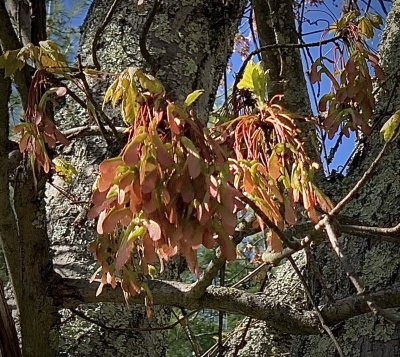
Red maple seeds in early summer
A friend collected some from his trees. I sowed them, they sprouted quickly, and I now have some healthy seedlings a foot or so tall.
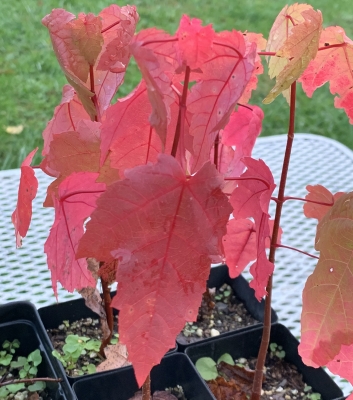
Red maple seedlings
Many woody plants bear seeds that don’t ripen until late summer or early fall. If these seeds sprouted as soon as they touched soil, the resulting tender, young sprouts would succumb to winter cold. To avoid this, they sit and wait until they feel that winter has passed. They gauge this, via their hormones, by the amount of cold they’ve experienced. Levels of the hormone abscisic acid, which keeps seeds dormant, decrease as cold wears on.
Seeds typically need exposure of one to two months, or about 1,000 hours, in a moist, cold environment before they can be convinced that it’s safe to sprout. Cold temperatures, between about 30 and 45 degrees Fahrenheit, not frigid temperatures, are what flick this switch. Depending on location, such temperatures might be experienced partly in fall and partly in spring, or mostly in fall.
Other types of dormancy might also need to be overcome before a seed will sprout. Some seeds have a separate dormancy for root growth, overcome with warm, moist conditions. Root growth must precede shoot growth.
Warm, moist conditions also may be initially needed for seeds with especially tough coats, to soften them or give microbes the opportunity to erode the surface.
Practical Matters
To start, I’m soaking the winterberry, holly, black tupelo, and Nanking cherry seeds in water for a couple of days, changing the water daily. Soaking does three things: First, it makes sure the seeds are well hydrated; second, it makes fruits fall apart to release their seeds; and third, it leaches out potential sprouting inhibitors. Sprouting inhibitors prevent seeds within moist, fleshy fruits from sprouting within.
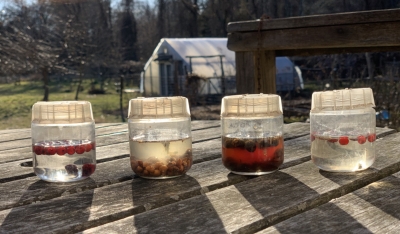
Winterberry, Nanking cherry, black tupelo, and holly seeds
In a couple of days, I’ll plant my soaked seeds in flats of potting soil, water them, cover them, and set them in my garage. (The holly and winterberry fruits still are more or less intact so I’ll just plant the whole fruits in the potting soil.) In the garage, temperatures are somewhat moderated as compared with outdoor temperatures.
As soon as the seeds sprout — still, after many years of doing this, an exciting moment for me — I’ll move them to a bright window, the greenhouse, or, depending on outdoor temperatures, outdoors.
After a few inches of growth, individual plants get more space in their own pots or a nursery bed. And, after a year or two, they move to their permanent homes.
I took seeds for the hollies and winterberries from clonal plants, that is, plants of named varieties. Clonal plants are exact replicas of the mother plants from which they were propagated. The holly varieties were all female, the variety Blue Princess, except for one male, Blue Boy, there to provide pollen so the Princesses would bear their flashy red berries. I can’t remember the variety name of my female winterberry.
Each of the seedlings I’ll be growing will be a genetic mix, each different from each other and their mothers, although not necessarily obviously so. In the case of holly and winterberry, half of the seedlings will, theoretically, be the more desirable females. (One male can sire as many as about eight females.)
All this may seem like a lot of trouble when I could just purchase plants from a nursery. But I find looking at a mature plant that I planted very rewarding. The amount of satisfaction I get is indirectly proportional to the size of plant I started with. Hence, growing trees and shrubs from seeds is especially satisfying.
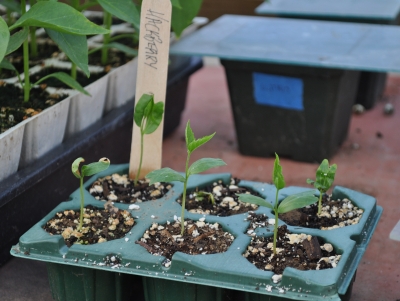
Hackberry seedlings in 2013; trees are now 15′ tall!
And Never the Twains Shall Meet
/15 Comments/in Flowers, Fruit, Pests/by Lee ReichDetente, Plant Style
“Oh, East is East, and West is West, and never the twain shall meet,” wrote Kipling a hundred years ago. Not so with respect to gardening. The Far East, spared the great sheets of ice that descended upon North America during the Ice Ages, has been a treasure trove of plants. Though distance, water, and culture kept the gardening worlds of the East and the West separate for millennia, the gap began to narrow just over two-hundred years ago.
The first plants to trickle out of China were those plants most accessible to foreigners — cultivated plants growing at and around seaport towns. It was not until the
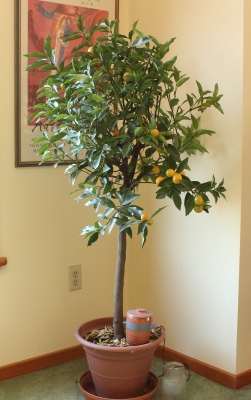
Potted kumquat
middle of the nineteenth century that plant explorers pressed inland to open wide the treasure chest of wild and cultivated plants, many of which have found their way into my garden. These plant explorers are honored in plants that bear their names. Fortunella, or kumquats (the genus was changed recently, with kumquats now in Citrus), named for Robert Fortune. I grew kumquats, wintering them indoors at a sunny window, for many years. Citrus meyerei, the Meyer lemon, named for Frank Meyer; my two Meyer lemon plants, also at sunny windows, are just beginning to send out new shoots, soon, with flowers.
(There is a darker side to “East meets West.” Up until the middle of the 19th century, Japan was isolationist, which was not to the liking of U.S. commercial interests. President Millard Fillmore enlisted “Admiral” Matthew Perry to force his boats into Japan’s Edo Bay to intimidate the Japanese into opening their ports to American trade, as well as other concessions. This gunboat diplomacy was successful.)
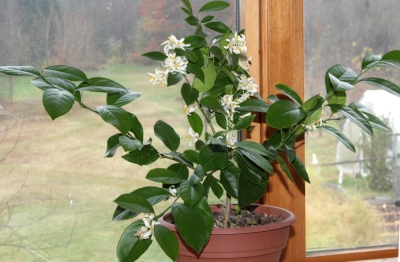
Meyer lemon in bloom
Trans-Pacific Cousins
From the Far East came plants for which we had no counterparts, plants such as the gingko tree. There also came plants more, or at least equally, valuable as related plants found here. We have our redcedar (Juniperus virginiana); from China comes Chinese juniper (J. chinensis). Our redcedars turn drab brown in winter, but the Chinese species remain lush green throughout the year.
Common witchhazel (Hamemalis virginiana) and vernal witchhazel (H. vernalis) are understory shrubs of American forests; Asian forests likewise have two witchhazel

Arnold’s Promise witchhazel, today
species: Chinese (H. mollis) and the Japanese (H. japonica). The Asian species blossom at different times than the American species, so are useful for extending the period of witchhazel bloom. My Arnold’s Promise variety of witchhazel, a hybrid of the Chinese and the Japanese species, is in bloom right now although blooms often wait until midwinter to open
Where East really does meet West in gardening is in hybrids of Eastern and Western species. The hybrid tea rose, common in American gardens from New England to the Southwest, is one example. “Tea” in the name traces back to a tea-scented rose (Rosa gigantea) from China. For centuries, the Chinese hybridized this summer-flowering climber having huge, yellow flowers with a dwarf form of another species, R. chinensis. In the nineteenth century these hybrids were further hybridized with European roses to make hybrid tea roses.
Pest Control
American plant breeders sometimes have had to look across the Pacific to find plants with resistance to a disease originally brought to America from the East. Chestnut blight turned up at New York’s Bronx Zoo in 1906, and within fifty years, the tops of American chestnuts (Castanea dentata) were dead or dying in seven million acres of Appalachian forests. The roots, which are not affected by the blight, keep sprouting new shoots, which then die after a few years, but keep the blight fungus “fed.”
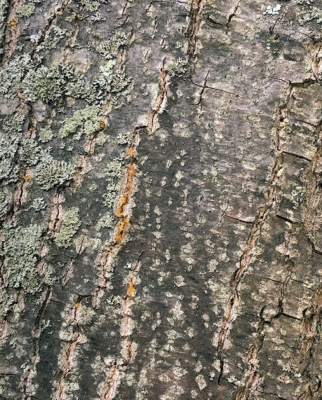
Blight on chestnut bark
Japanese chestnut (C. crenata) and Chinese chestnut (C. mollisima) evolved with the blight and show some resistance to it, so have been hybridized with the American species to produce blight-resistant trees, such as the variety Sleeping Giant. These trees lack the grandeur of the American chestnut, but they do make larger nuts. My chestnuts, the varieties Colossal, Marigoule, and Precoce Marigoule, are hybrids of European chestnut (C. sativa) and Japanese chestnut. They’re all blight resistant, but resistance is a matter of degree. My Colossal is finally succumbing to blight.
Dutch elm disease entered America via Europe, but entered Europe from Asia, probably about the time of World War I. Once again, Asian elm species — Chinese elm (Ulmus parviflora) and Siberian elm (U. pumila) — are resistant to the disease. Hybridization has produced such disease-resistant varieties as Patriot and Accolade.
Plants of Asia even have been useful in providing resistance to diseases not originating in Asia. Fireblight disease of pears was first noted in New York’s Hudson Valley at the end of the eighteenth century. Some Asian pear species are resistant to fireblight. Over a hundred years ago, hybrids between Asian and European pears that showed some resistance to blight were produced, at first by accident. These original hybrids did not taste very good, but did make pear-growing possible in blight-prone southeastern U.S.
The story isn’t yet over. Expeditions still return from such areas as remote villages and forest of China and the Himalayas to yield “new” plant treasures.
GIFT IDEAS
/2 Comments/in Books/by Lee ReichGreat Gift Ideas! Gardening books, of course. All available from the usual sources as well as, signed, right from me, here.
Weedless Gardening: Not only weedlessness; also lots of information on drip irrigation, making or buying compost, cover crops, timing and details for individual vegetables, tree planting, fertilization, and soil testing. 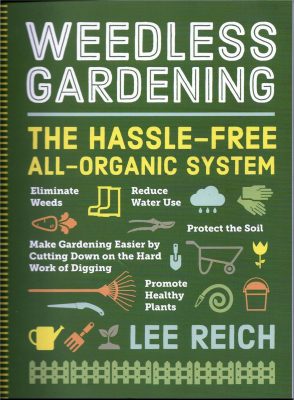 I’ve used this weed-less system for over 25 years! $10.95
I’ve used this weed-less system for over 25 years! $10.95
Growing Figs in Cold Climates: Five methods for growing figs in cold climates, pruning techniques, best varieties, harvesting, and  ways to hasten ripening. $24.99
ways to hasten ripening. $24.99
The Pruning Book: Reasons to prune, tools of the trade, how plants respond to being pruned, and details on just pruning just about every plant you can imagine, from ornamental trees and bushes, to fruit and nut trees, to houseplants and perennials. A final section delves into specialized techniques such as topiary, bonsai, and espalier. $29.95
from ornamental trees and bushes, to fruit and nut trees, to houseplants and perennials. A final section delves into specialized techniques such as topiary, bonsai, and espalier. $29.95
Landscaping with Fruit: How to choose what to grow depending on your region and particular pest or climate problems, and details for individual plants 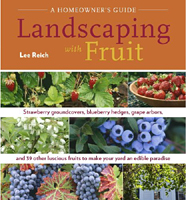 (the ornamental value, how easy they are to grow, what they taste like, varieties). Also a chapter on landscape design basics. $19.95
(the ornamental value, how easy they are to grow, what they taste like, varieties). Also a chapter on landscape design basics. $19.95
A Northeast Gardener’s Year: Month by month, chapter by chapter, in the garden. Each chapter begins with a snippet of borrowed poetry to set the tone, followed by a  short description of what is going on plantwise. From there we are left to the whims and vagaries of the weather and the weeds, the unfolding of blossoms and ripening of fruits, perhaps the cry of a plant begging to be repotted — any and all topics gardenwise. $17.00
short description of what is going on plantwise. From there we are left to the whims and vagaries of the weather and the weeds, the unfolding of blossoms and ripening of fruits, perhaps the cry of a plant begging to be repotted — any and all topics gardenwise. $17.00
The Ever Curious Gardener: Using a Little Natural Science for a Lot Better Garden: An irreverent romp through the natural science of plants and soil, ideal for  everyone from newbies to experienced gardeners whose curiosity at the wonders of cultivation grows deeper and stronger with each season. How to maximize flavor and nutrition; how to help plants outwit drought; making the best sse of compost; etc, etc. $18.99
everyone from newbies to experienced gardeners whose curiosity at the wonders of cultivation grows deeper and stronger with each season. How to maximize flavor and nutrition; how to help plants outwit drought; making the best sse of compost; etc, etc. $18.99
Grow Fruit Naturally: How to successfully grow fruits that are delicious and nutritious without toxic chemicals. Covers planning, propagation, pruning,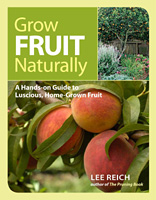 pest control, storing your bounty, and growing fruit plants in containers. Details on over 30 fruits and how to reap their bounty. $24.95
pest control, storing your bounty, and growing fruit plants in containers. Details on over 30 fruits and how to reap their bounty. $24.95

